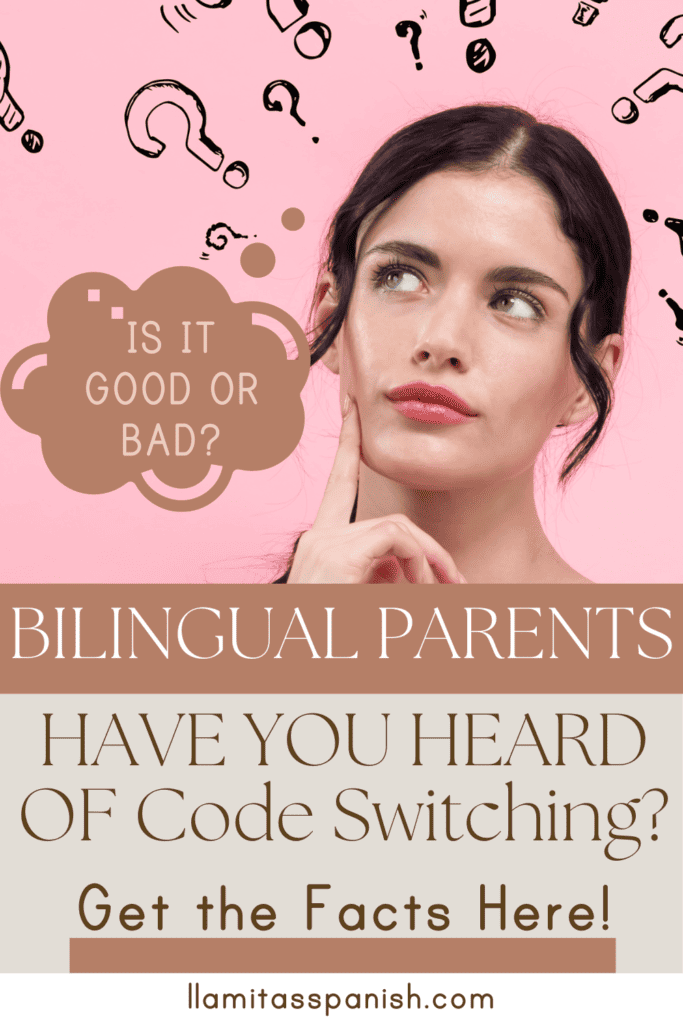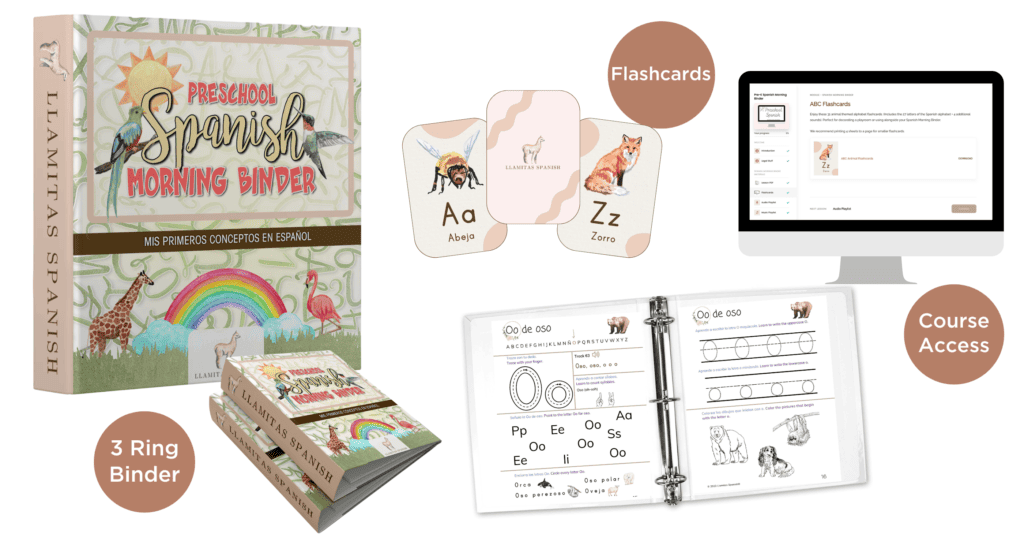In this post: What is code-switching when speaking languages and is it good or bad?
One of the most interesting aspects of growing up bilingual is the ability to quickly switch between two languages on the fly in the middle of a conversation – and even in some cases, right smack in the middle of a sentence!
This natural phenomenon is often referred to as code-switching, and one can easily observe this among bilingual speakers who share two or more languages. In fact, code-switching can be one of the most creative and fun privileges of speaking dos idiomas.
Related post: The Benefits of Raising Bilingual children

Table of Contents
What is Code-Switching?
Code-switching is not inherently a bad thing, and actually it can be useful. In fact, many scientists, such as noted American psychologist Donald D. Hoffman who is known for his highly acclaimed books on human perception, believe that code-switching serves as a valuable linguistic exercise that strengthens the memory centers in the brain.
But, while individuals who grow up bilingual may feel perfectly comfortable engaging in conversations that include more than one language, many monolingual speakers may be thrown for a loop upon hearing these code-mixed sentences and expressions.
As parents raising bilingual children in the USA, the most important thing to help your kids understand about code-switching is that there is an appropriate time and place for it. In some cases, it can work to enhance what you’re trying to say, while in other cases, you may simply leave your listener stumped.
Successful code-switching begins with a successful command of both languages. To help your little learner become a bilingual global citizen, start by enrolling in our Llamitas Spanish Curriculum for done-for-you thematic Spanish lessons.

We also offer a FREE Spanish Resource Library which provides printable, screen-free materials, along with Spanish songs, games, and much more! Our content is updated regularly to help keep your little linguist engaged and enjoying every step of their Spanish learning journey!
How does Code-Switching Work?
Code-switching is simply the ability to switch seamlessly between two languages while expressing a single thought, or in the context of a single conversation.
Code-switching is becoming more and more common among bilingual and multilingual communities around the world, and is now normalized in many U.S. cities such as Miami, Los Angeles, San Diego, Houston, and many others, where multicultural populations are increasingly sharing one another’s languages.
Related Post: Dual Language Homeschool Education
Common Types of Bilingual Code-Switching
While code-switching can happen seamlessly, it may take different forms. Hoffman and other scientists have identified various types of bilingual or bicultural code-switching, based on how the switching happens and the reasons for it.
1) Intra-sentential Code-Switching
Intra sentential code-switching happens within the confines of a grammatical clause, phrase or sentence via the simple insertion of words from one language into clauses or sentences in another language, as in these cases:
- I want a puppy, pero Mom said we can’t have one.
- Yo no quiero ir al parque because it’s too hot there.
- I invited Elena to mi casa, but ella no pudo venir porque era Sunday.
2) Intra-lexical Code-Mixing
This kind of code mixing is somewhat more complicated and happens within the boundary of an actual word, to which an ending or other lexical morpheme is added, as in the following cases:
- It was a baby duckito
- Estaban surfeando
3) Altering the Pronunciation of a Word or Phrase
Another type of code mixing happens at the phonetic level, when speakers of a certain language collectively incorporate words from another language into their culture, but alter the pronunciation of those words. Examples of this include pronouncing words such as “picnic” as “picní,” “downtown” as “dontón,” “special” as “especial” or “sandwich” as “sanduche.” In reverse, you might hear words like “jalapeño” pronounced as “jalapeenyo” or “Chile” pronounced as “Chilli.”
4) Inter-sentential Code-Switching
Inter-sentential switching happens between the boundaries of an individual clause or sentence. In this type of code-switching, the speaker may say an entire clause or sentence in one language, then switch to the other language for the next clause or sentence. Examples of this type of code-switching include:
- Do you want my toy? Ya no lo quiero.
- Vamos a la biblioteca. I want to find a book about dogs.
5) Tag Switching
This type of code switching simply involves the insertion of an interjection, sentence filler, or “tag” that serves as a cultural marker in the other language. Examples of tag switching include:
- Siempre pasa lo mismo, right?
- It has to fit perfectly, ¿me entiendes?
- Viven, you know, allá lejos
- Oye, leave that alone!
What is the Purpose of Code-Switching?
This leads us to the question of why code-switching behavior occurs, and when is it appropriate to code-switch. For many parents raising bilingual kids, it may be irritating to hear code-switching. But, in reality, not all code-switching is inappropriate.
While some purists argue that code-switching is a sign of linguistic laziness, or an inappropriate use of language, there are actually a number of valid reasons to deliberately switch between languages within a single sentence or conversation, and in certain instances, it may actually be appropriate and even necessary. Some instances where code-switching is useful include:
- When quoting someone
- When addressing a multilingual group
- When discussing a subject that requires the use of specific words in a specific language
- When emphasizing a specific cultural point
- When an idea makes more sense in one language than the other
- When expressing solidarity with a specific group
- When clarifying a point of reference or meaning
- When using specific sayings or colloquialisms
- When attempting to keep sections of a conversation from being heard by outsiders
Code-switching can also occur unintentionally. Sometimes, a speaker will simply switch into a different language without even realizing it! In many cases, bilingual individuals will use code-switching when sharing personal information or recalling family memories.

Code-Switching in Young Children
If your young bilingual speaker is using a lot of code-switching, it may be because they are not yet able to express themselves completely in both languages. Using words and phrases from both languages at once allows them to widen the range of their expression.
Related post: 10 Myths about Raising Bilingual Kids
When you hear your child code-mixing in both languages, it’s fine to encourage them for being so creative in their bilingual expression, and remind them what a privilege it is be able to code-switch like that. But you can also remind them that their monolingual peers may not fully understand them if they speak this way in certain circumstances.
In order to encourage your child to speak full sentences that are fully grammatically correct in both of their languages, ask them to repeat the sentence they just said using only Spanish words, or only English words only.
Don’t stress this, and don’t make the child feel like they’ve done something wrong. Make it fun and let them learn that there are many ways to express the same thing, and the more ways that they have at their disposal, the more creative their self-expression can be.
The best way to help your child fully understand the secret power of code-switching, it’s important to help them develop a comfortable level of fluency in both languages.
Take advantage of our FREE resources to help enhance your child’s Spanish-language learning journey and make learning Spanish more fun and más creativo every day.

